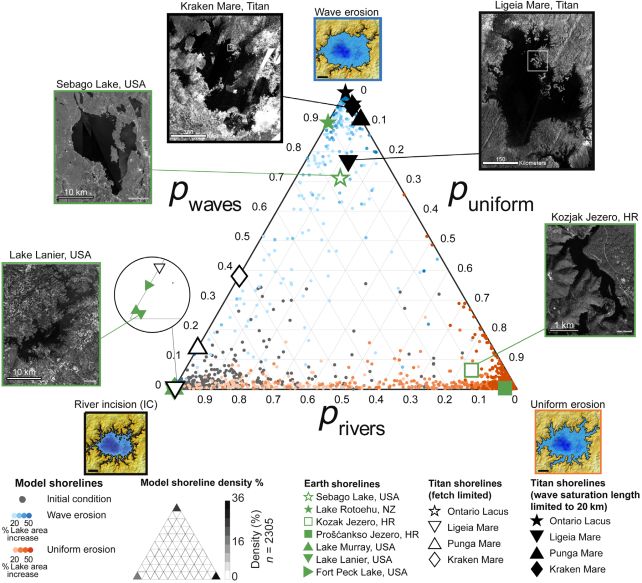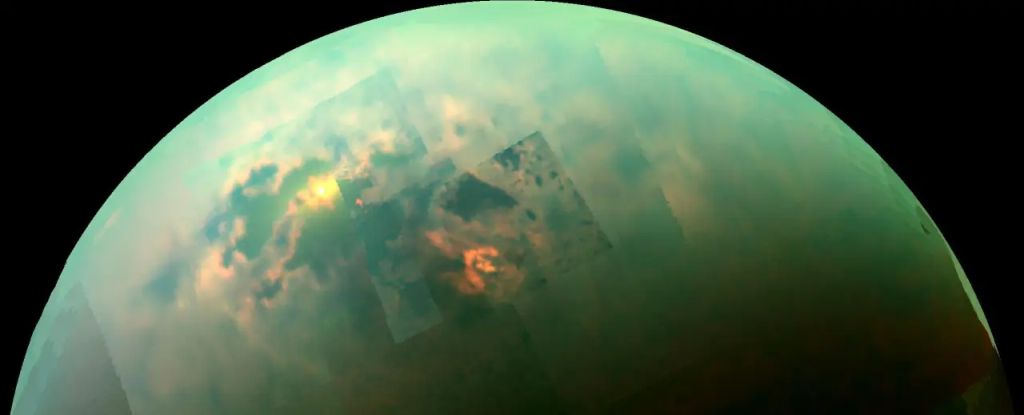The roar of the surf could be the soundtrack to Saturn’s moon Titan.
New analysis shows that the vast amounts of liquid methane and ethane wrapping around Titan’s surface are likely populated by waves that erode the coastline and carve the shapes of the vast rivers and lakes native to the exotic, hazy moon.
This discovery provides a fascinating insight into Titan and the way liquid bodies can behave on other worlds so different from Earth.
“Based on our results, we can say that if the coastlines of Titan’s seas have eroded, waves are the most likely culprit,” said geologist Taylor Perron of the Massachusetts Institute of Technology (MIT).
“If we could stand at the edge of one of Titan’s seas, we could see waves of liquid methane and ethane lapping and crashing onto the shores during storms. And they would be able to remove the material that makes up the coast is made to erode.”
Discovered by Christiaan Huygens in 1655, Titan’s surface is obscured by a thick, hazy atmosphere that was formally identified when Gerard Kuiper discovered methane in its spectrum in 1944. It was not until the Cassini probe was sent into Saturn’s orbit in the early 2000s that the Kronian moon’s surface was described in detail. Detail including vast, glistening lakes of liquid hydrocarbons.
Since then, scientists have wondered what these bodies of methane and ethane — some of which rival North America’s Great Lakes in size — look like.
Aside from Earth, Titan is the only known body in our solar system with giant reservoirs of liquid on its surface, and we’re so intrigued. Are the seas turbulent and always moving, like the oceans on Earth? Or are they calm and quiet, without significant movement?
“Some people who tried to see evidence of waves saw none and said, ‘These seas are as smooth as a glass,'” says geologist Rose Palermo of the US Geological Survey. “Others said they saw some roughness on the liquid surface, but weren’t sure if waves were causing it.”
To find out, Perron, Palermo and their colleagues ran detailed modeling, trying to replicate the shapes of the waterways and lakes seen in images of Titan.
First, they looked at Earth and ran models to figure out how different coastal erosion mechanisms shape the coastlines of bodies of water like lakes and oceans. This gave them a basic framework for using shoreline morphology to distinguish the different erosion processes that can be at play around a body of fluid.
They then applied this framework to Titan, looking at three specific scenarios: one in which there was no coastal erosion; a second in which erosion was driven by waves; and a third in which erosion was a uniform process, with coastal material gradually dissolving or falling away under its own weight.
Of particular interest is a property known as fetch, the distance over which a wind can pass unhindered over a body of liquid, transferring energy to the liquid’s surface. The longer a wind can travel, the more energy is transferred and the wilder the surface becomes.
“Wave erosion is caused by the height and angle of the wave,” says Palermo. “We used fetch to approximate wave height, because the larger the fetch, the longer the distance over which wind can blow and waves can grow.”

According to their simulations, the three scenarios produced very different coastlines. The ones that most resembled the real Titan are those in which waves crashed or lapped onto the shore. And those with uniform erosion ultimately resembled lakes on Earth that eroded in the same way, like the dissolution of limestone.
Of course it is not concrete evidence. We won’t know if there are waves on Titan until we go there and take a closer look. There’s a mission in the works to do just that, called Dragonfly. The expected arrival on Titan is currently scheduled for 2034, so we’ll just have to wait and see until then.
“Titan presents this case of a completely untouched system,” says Palermo. “It could help us learn more fundamental things about how coasts erode without the influence of humans, and perhaps that could help us better manage our Earth’s coastlines in the future.”
The research was published in Scientific progress.
